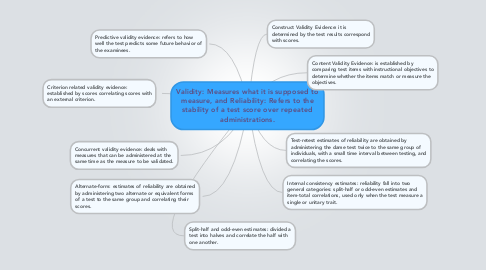Validity: Measures what it is supposed to measure, and Reliability: Refers to the stability of a test score over repeated administrations.
by Reneka Harrison

1. Criterion related validity evidence: established by scores correlating scores with an external criterion.
2. Concurrent validity evidence: deals with measures that can be administered at the same time as the measure to be validated.
3. Predictive validity evidence: refers to how well the test predicts some future behavior of the examinees.
4. Alternate-form: estimates of reliability are obtained by administering two alternate or equivalent forms of a test to the same group and correlating their scores.
5. Split-half and odd-even estimates: divided a test into halves and correlate the half with one another.
6. Construct Validity Evidence: it is determined by the test results correspond with scores.
7. Content Validity Evidence: is established by comparing test items with instructional objectives to determine whether the items match or measure the objectives.
8. Test-retest estimates of reliability are obtained by administering the dame test twice to the same group of individuals, with a small time interval between testing, and correlating the scores.
9. Internal consistency estimates: reliability fall into two general categories: split-half or odd-even estimates and item-total correlations, used only when the test measure a single or unitary trait.


